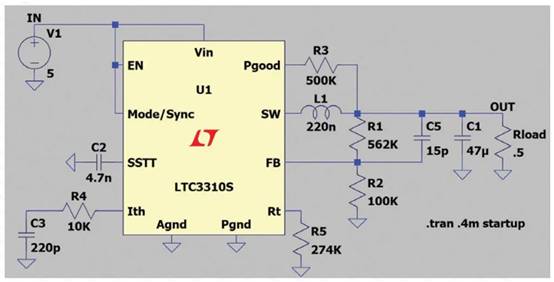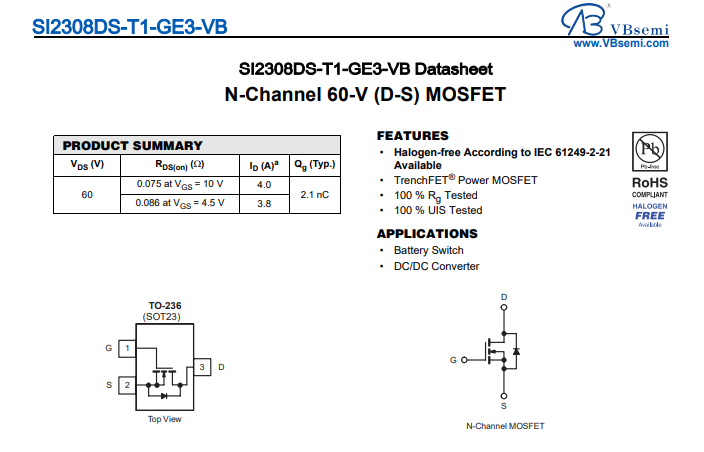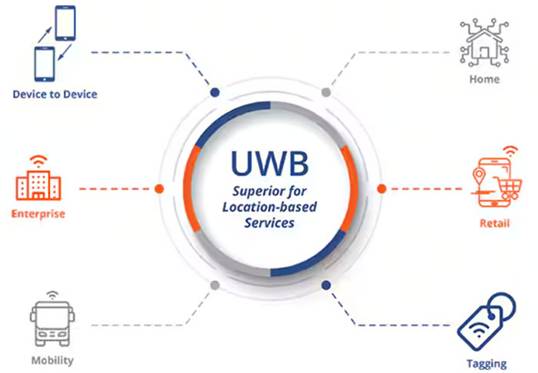文章转自ADI官网,版权归属原作者一切
Introduction
You are probably aware that your mobile phone has a camera module in it; but if it’s more than a few months old, or it wasn’t terribly expensive, it’s a good bet that, if you photograph someone committing a crime, the resulting blurry images—whether due to insufficient resolution, poor focusing, or movement during exposure—will not be admissible in court. But the camera module’s resolution, and performance in general, is improving quickly. In 2000 Samsung released the SCH-V200, a 0.3-megapixel (MP) camera phone, and in 2003 NTT DoCoMo launched the first autofocus handset camera, the 1.3-MP P505iS. Last year Sony Ericsson launched what many consider the first real camera phone, the 2-MP K750i with autofocus. And in March of 2006 Samsung announced the SCH-B600, a 10-MP camera phone!
What is now called the “Evolution of Resolution” is driving camera module development. In order to make the best use of the increased resolution, effective and rapid autofocus (AF) must accompany the increase in pixels. With autofocus becoming a standard feature, ever-increasing resolution will call for more camera features, such as optical zoom, shutter control, and image stabilization (Figure 1).
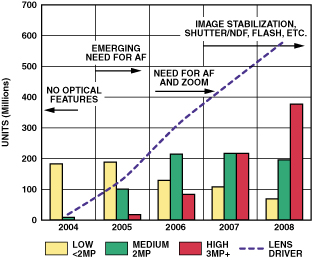
A key element of many features is the ability to move the lens rapidly so as to achieve optimum focus. The lens driver provides the power that moves the lens appropriately in response to digital control signals. We will discuss the lens driver’s role, describe two useful new products, and consider the future of lens drivers in the marketplace.
Figure 2 is a generic block diagram, or signal chain, of a digital camera. The image projected by the lens onto a CMOS- or CCD (charge-coupled-device) sensor is scanned and applied to an analog front-end processor (AFE), which amplifies and conditions the raw video signal, and converts it to digital. The AD9822, for example, is a complete 14-bit analog signal processor for CCD imaging applications, featuring a 3-channel architecture designed to sample and condition the outputs of trilinear color-CCD arrays. once the image is in digital form, it can be edited, downloaded, or stored, and further processed for camera operations, such as gamma-correction, light sensitivity adjustment for flash, and lens drive for focusing. Beyond these basic elements, additional sensors can measure lens position, light, temperature, acceleration, and angular motion (these last for image stabilization)—and motors/actuators can control the shutter, neutral density filter (NDF), iris, and lens cover.
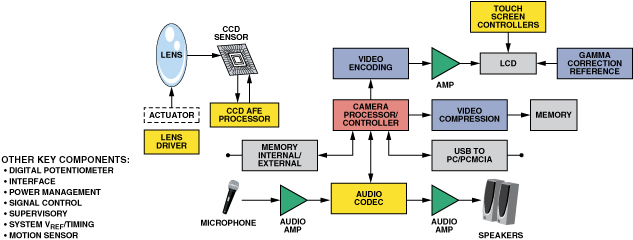
Handset Cameras vs. Digital Still Cameras
Camera phones are the fastest-growing consumer market in the world today and will continue to be for the next several years. Size and cost of these modules are of primary importance, but coupled with this, users are demanding real camera performance. In fact, performance convergence between new camera phones and the digital still cameras (DSCs) of a couple of years ago has already occurred.
High-resolution digital still cameras are readily available at low cost, but their technology is not immediately transferable to handsets. Why not? Their requirements are rather different. DSCs are cameras, first and foremost—while the primary function of the handset is to make a call and speak to somebody. The included camera module is one of those useful additional features that may come in handy at times, but it can’t add substantially to cost—or make the phone bulkier. In addition, there are severe power-consumption restrictions on camera modules: a camera module that eats significantly into talk time will never be a success.
Lens Driver
A lens driver controls the actuator that moves the lens assembly back and forth to adjust focus and/or magnification in camera phones with resolutions typically greater than two megapixels. Cameras with lower resolutions typically do not require autofocus, so they do not require a lens driver. In addition to focusing, some higher-resolution cameras may use lens drivers to position the lens for image stabilization. Figure 3 shows a lens driver and many of its possible inputs and outputs.

Traditionally, DSCs use digital stepper motors as actuators; the stepper has proven to be robust, easy to drive, and it can be used to drive both autofocus (AF) and zoom lens actuators. Another advantage of the stepper is that after a lens movement is complete, and the required focus or magnification is achieved, no holding power is required to keep the lens in place. But steppers currently used in DSCs are physically large, relatively expensive, mechanically complex, noisy, slow, and power-hungry. These factors all tend to make the current crop of steppers unsuitable for camera modules in phones. Furthermore, as features are added to camera phones, it is becoming obvious that space constraints will require a very high degree of integration—a severe disadvantage for the current stepper technology.
An emerging actuator technology is based on piezoelectric materials, of which there are many flavors. The piezoelectric actuator is mechanically simple, can make rapid movements, and is energy efficient. It can be used for both AF and zoom applications, and no hold power is required to maintain lens position after a lens movement is complete. Unfortunately, the drive schemes for piezoelectric elements are complex and still in flux. Also, piezoelectric materials have a high temperature coefficient, demanding temperature compensation of frequency, phase difference, and duty-cycle of the drive signals.
The third option in actuator technology, the voice-coil motor (VCM) with spring return, is the smallest, lowest-cost solution for autofocus on the market today; it is also the simplest to implement. These factors are important because camera modules with autofocus are currently the highest-volume products in this market.
Movements using VCMs are repeatable and gearless, with lens position fixed by balancing motor and spring forces. The spring returns the lens to the infinite-focus position, and no power is dissipated unless focusing is required. It is mechanically robust, shock-resistant, and has low-cost mechanics. These motors have no hysteresis and therefore have a direct current-vs.-position relationship, so that lens-position feedback may not be normally required.
Figure 4 shows the transfer curve of a typical spring-preloaded linear motor for autofocus—and the dimensions of a typical VCM intended for use in a camera phone. The transfer function shows displacement, or stroke, which is the actual distance the lens moves (mm), vs. the current through the motor (mA).
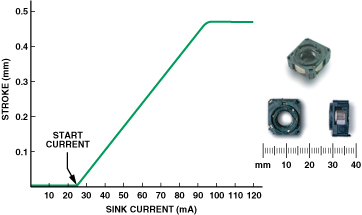
The start current, or threshold current that must be exceeded for any displacement of the spring-preloaded linear motor to occur, is usually 20 mA or greater. The rated stroke or displacement is usually 250 mm to 400 mm, and the slope of the transfer curve is on the order of 10 mm/mA. The maximum lens displacement for autofocus is of the order of 300 mm to 400 mm, so the VCM is a good fit for this level of functionality. Unlike the piezoelectric actuator and stepper motor, however, the VCM does consume power while holding the lens in focus.
Table I compares the best-in-class actuator technologies available.
Table I. Actuators Compared
| Motor Type |
Voice Coil Motor (VCM) |
Piezo Motor | Stepper Motor |
| Size | Small | Small | Largest |
| Cost | Lowest | Low | Highest |
| Speed (Autofocus) | 10 ms | 3 ms | 100 ms |
| Energy (mJ) | 2.4 | 0.7 | 21 |
| Bidirectional | Yes—with spring | Yes | Yes |
| Index/Rest Position | Yes | No | No |
| Repeatability | Good | Poor | Medium |
| Gears Required | No | No | Yes |
| Acoustic Noise | — | — | High |
| Power Transistors to Drive Motor | 1 | 4 | 8 |
| Application | AF and on/off functions | AF and zoom | AF and zoom |
Driving the VCM for Autofocus
Analog Devices currently manufactures the only fully integrated product specifically aimed at allowing camera designers to take full advantage of the emerging market for AF. A complete VCM-driver solution, the AD5398 comprises a 10-bit digital-to-analog converter (DAC) with 120-mA output-current-sink capability, intended for driving voice-coil actuators in applications such as lens autofocus and image stabilization. The AD5398 is controlled using the industry-standard I2C® 2-wire serial protocol. A second VCM driver, the AD5821, is scheduled for release in December 2006. The AD5821 has the same feature set as the AD5398, but includes a 1.8-V-compatible interface—and its hardware shutdown pin, XSHUTDOWN, is active low (on the AD5398, it is active high). Figure 5 shows a block diagram of the AD5821. A 10-bit current-output DAC, loaded by resistor, R, generates a voltage that drives the noninverting input of the operational amplifier. Feedback causes this voltage to appear across RSENSE, generating the sink current required to drive the voice coil.
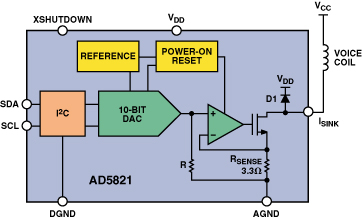
Resistors R and RSENSE are interleaved and matched on-chip. Their temperature coefficients and any nonlinearities over temperature are therefore matched, minimizing the output drift over temperature. Diode D1 provides output protection, and dissipates the energy stored in the voice coil when the device is powered down.
The Future
Stepper motor manufacturers will be forced to reduce size and cost. This will require drivers having a higher degree of integration, more efficient drive schemes, lens position feedback, smaller size, and lower cost. Many camera module manufacturers are experimenting with piezoelectric actuators, which in themselves present a great many challenges to lens-driver manufacturers. Also not far off are electrically focused liquid lenses.
Figure 6 shows a conceptual block diagram of a piezoelectric solution for lens driving. This could also apply to stepper drivers, except that the number of drivers required would be doubled.
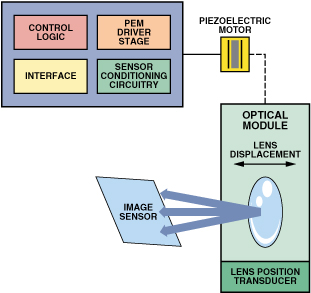
Piezoelectric actuators require a drive with a mixture of analog drivers, digital flexibility, signal conditioning and conversion, and, in some cases, power management. Analog Devices has expertise in all of these areas. The camera module for the handset market is complex and multilayered; there is an interdependency between companies making the image sensors, those who produce the mechanics for the optical module, the lens manufacturers, and the lens driver manufacturers. Digital still cameras are evidence of what can be achieved by dedicated design, but one of the primary challenges in reducing size, cost, and power is to further integrate additional functionality within the lens driver. As camera modules continue to evolve, ADI will continue to lead in the development of new lens drivers and other components.



